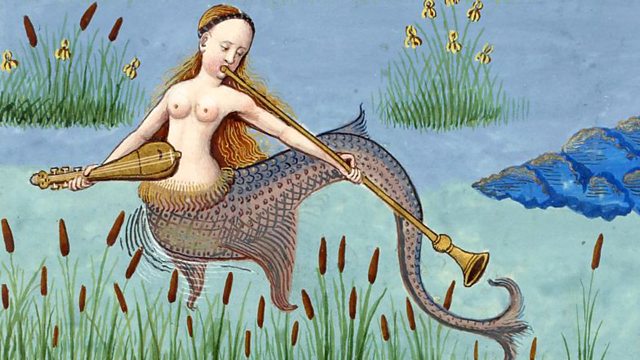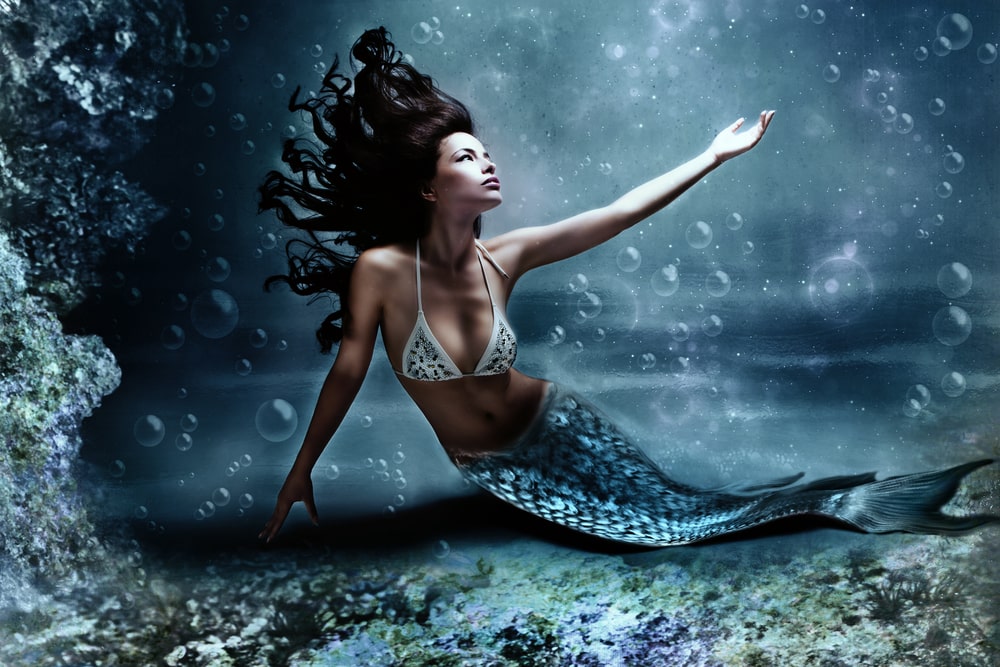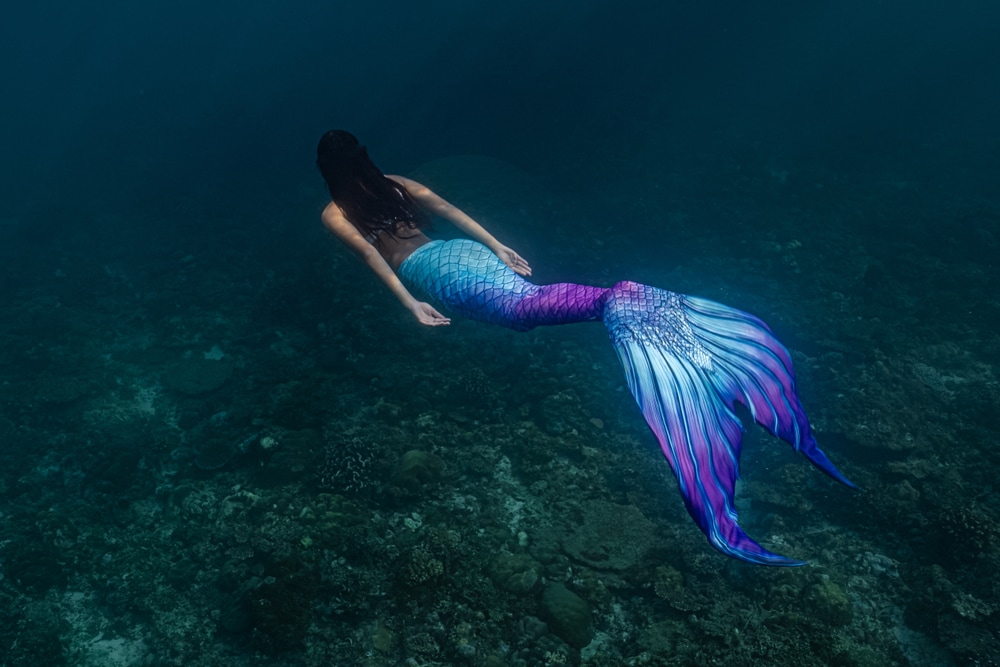Outforia Quicktake: Key Takeaways
- Mermaids aren’t real, but rather mythological creatures with the torso and head of a human and the tail of a fish.
- The word mermaid comes from the Middle English words mere, meaning sea or lake, and mayde, meaning woman.
- The first depiction of a half-human, half-fish creature is thought to be of the ancient Babylonian water god Oannes dating from the 4th century BCE.
- The goddess Atargatis from Assyrian mythology is considered the first proper mermaid in human culture.
- Mermaid myths may have originated from misidentifying real-life animals such as Japanese Giant Salamanders, manatees, and dugongs.

Oceans are mysterious places populated by truly bizarre creatures.
Take the Psychrolutes marcidus, generally known as the blobfish, for example. This deepsea dweller looks like an average fish in the water but turns into a slimy, pug-faced blob when taken out.
There’s also the oarfish (Regalecus glesne), an open-ocean fish that swims vertically when feeding. They can reach lengths of over 30 feet (9.1 m). They are so long that some believe they’re responsible for sea serpent sightings.
And how about the goblin shark (Mitsukurina owstoni), a 12-foot-long (3.7 m) beast of the deep with a long nose, an extendable jaw that shoots forward to catch prey, and long, jagged knife-like teeth.
And, of course, one of the ocean’s most famous and mysterious creatures: the mermaid. So, are mermaids real? There are an estimated 700,000 unidentified species in Earth’s oceans. Could one of those creatures be a mermaid?
Frankly, no. Mermaids are not real. They are mythological beings created by human imagination or real animals mistaken for something they’re not.
But, despite not inhabiting our oceans, something can be said about the popularity and persistence of the mermaid myth.
So what are mermaids, and what are their origins? In this article, we’re taking a deep dive into the myth of the mermaids. We’ll explore what they are, their origins, and how misidentifying real-life animals may have spawned these legendary creatures.

Share This Image On Your Site
<a href="https://outforia.com/sharks-in-florida/"><img style="width:100%;" src="https://outforia.com/wp-content/uploads/2022/01/Sharks-in-Florida-infographics-01112022.png"></a><br>Sharks in Florida Infographic by <a href="https://outforia.com">Outforia</a>What Are Mermaids?

Mermaids are creatures with the torso and head of a human and the tail of a fish. Typically, they are portrayed with the upper body of a woman. However, male counterparts known as mermen were also said to exist.
In European myth and folklore, mermaids and mermen were similar to fairies. They had magical and prophetic abilities, and even their own underwater culture and society. They’re said to live for hundreds of years and enjoy music, especially singing.
In some tales, mermaids could take human form and walk on land. Sometimes, they even would marry humans.
But not all of them were benevolent beings. Some stories tell of mermaids drowning people, luring sailors into shipwrecks, or kidnapping and stealing them to the depths of the sea.
The Etymology of “Mermaid”

The word mermaid comes from the Middle English words mere, meaning sea or lake, and mayde, meaning woman. As a whole, the word mermaid means “woman of the sea.”
Old English had an equivalent term, merewif, which means “sea woman” or “sea witch.” Wif is Old English for woman, lady, and girl. It’s still a root of some Modern English words like “wife” or “woman,” originally wifman.
You May Also Like: 14 Of Our Favorite Ocean Animals Listed: A World Of Wonders
Origin of the Mermaid Myth

It’s difficult to judge precisely when the mermaid myth began. However, we have some clues on the origin of these mythological creatures.
Oaeness and Ea, Mesopotamian Water Gods
The first depiction of a half-human, half-fish creature is thought to be of the ancient Babylonian water god Oannes dating from the 4th century BCE. Oannes supposedly gifted humankind with the wisdom of arts, sciences, and writing.
However, Oaness isn’t depicted like a typical mermaid. Instead, he’s usually portrayed as a fish but has a human head underneath the fish head and human legs sticking out from below his tail.
Oannes is the messenger of another Mesopotamian god named Ea or Enki. Ea, the god of the sea and waters, was one of the major gods in the Mesopotamian pantheon. He is also considered a fertility god.
Ea was sometimes depicted as half-fish and half-man. However, some depictions show him with a human body covered in fish scales. Other depictions of Ea show him as half-fish and half-goat. This is where we derive the modern image for the zodiac sign Capricorn.
So, we discovered the origin of the image for Capricorn. But, these ancient gods don’t align with how mermaids are usually depicted. So, why bring up Oannes and Ea anyway?
Well, the kingdoms of ancient Mesopotamia existed from roughly 45000 BCE to 539 BCE and were the first civilizations on our planet. The fact that they had a merman-esque figure in their mythology means the image of a half-fish, half-human, is as old as civilization itself.
However, if we want a first look at more modern depictions of mermaids, we’ll have to fast-forward through time to 1000 BCE in ancient Assyria.
Atargatis, Goddess of Ancient Assyria
The goddess Atargatis was a fertility goddess and a significant deity in Assyrian mythology. There are multitudes of stories about Atargatis, but one is particularly relevant.
The story goes that Atargatis fell in love with a mortal man. She seduced him, and the two produced a demi-god child named Semiramas. However, her human lover didn’t survive copulation with the goddess. So, out of grief for her lost lover, Atargatis threw herself into a lake.
Apparently, “her beauty was such that she could not die nor be fully transformed into a fish, and so she retained her feminine shape and beauty above the waist while having a fish tail instead of legs.”
And so, with the goddess Atargatis, we have our first image of a proper mermaid in human culture.
The Nereids of Ancient Greece
The ancient Greeks had their own version of mermaids known as nereids.
Nereids were daughters of the Greek god Nereus, the god of the sea (similar to Poseidon). They inhabit fresh and salt waters and are commonly depicted as half-woman and half-fish.
Unlike other mermaids, nereids were often kind and helpful to people. For example, nereids were known to guide sailors to safety during storms.
But what about the sirens in Homer’s The Odyssey? Weren’t they mermaids? Well, not exactly. But we’ll come back to this later in the FAQ section.
Mermaids in Japanese Culture
The Japanese also have a mermaid-like creature called ningyo, which translates to “human fish.”
These creatures inhabited all bodies of water, but especially rivers and streams. They are sometimes depicted as being half-woman, half-fish, like Western mermaids. However, they are also sometimes shown as a fish body with the head of a human.
Ningyos are considered ill omens. Sighting one or catching one would bring trouble. However, they say if you eat a ningyo’s flesh, you could live for hundreds of years.
A Case of Misidentification

Now that we have a better understanding of what mermaids are and their various depictions in world myth, let’s talk about what might have spawned these myths in the first place.
Imagine, if you will, that you live in the hot summers of rural Japan. Looking for relief, you walk to a nearby stream to wade through the cool waters.
Suddenly something brushes against your leg and there lies …a monster! A creature the size of a man, slimy and dark, with arms and legs and hands with stubby fingers stretching towards you.
You panic and flee for home before you can get a better look at the creature. Before long, the village hears of the human-fish monster lurking in the river, and a legend is born.
But was it a monster?
Inhabiting the rivers of Japan are the Japanese Giant Salamanders. These salamander species can reach lengths over 5 feet (1.5 m) and weigh over 55 lbs (24 kg).
To ancient peoples or someone unfamiliar with Japanese fauna, these startling creatures might look like humanoid fish. Especially when they’re partly concealed beneath the rapids of a river or only briefly glimpsed.
The point is, it’s easy to conflate an ordinary thing into something extraordinary, as shown in the example above. Let’s look at the case of the giraffe, for example.
Camelopardalis

The ancient Greeks knew of the lions and hippos of Africa. But giraffes were a different story. For a while, the only knowledge Greeks had of giraffes was from second-hand accounts and descriptions.
When trying to describe a giraffe to the Greeks, some traveler or another made comparisons to animals the Greeks were familiar with. “The creature has the spots of a leopard and the body of a camel,” you can imagine them saying.
Naturally, the human imagination likes to run wild with such comparisons. So the giraffe became a legendary creature known as the camelopard– a camel and leopard hybrid.
So, a perfectly natural animal became a creature of legend because of misinterpretation of its description.
It’s the same with the Japanese Giant Salamander. Some believe them to be the origin of the ningyo myth.
But what about mermaids? Could they also have originated because someone misidentified some other creature? As a matter of fact, yes.
Dugong and Manatees, the Real Mermaids

During one of his voyages to the New World, Christopher Columbus thought he saw a mermaid swimming by his ship. He even recorded the encounter in his journal. He stated, quite comically, that they were “not half as beautiful as they are painted.”
That’s because they weren’t mermaids at all– they were manatees! And his journal entry is the first recorded sighting of manatees in North America.
A similar story is that of John Smith, who supposedly saw a mermaid swimming in the West Indies. He described the creature as “by no means unattractive.” For the sake of John Smith, I hope it was a mermaid and not a manatee. Manatees are cute and all, but attractive?
Anyway, we should note that this story of John Smith’s encounter with a mermaid is likely fictional and was never recorded by John Smith himself.
It’s the same story with dugongs, except they live in Indo-Pacific waters and not in North America like manatees. People suspect dugongs started the mermaid myth. In fact, the taxonomic name for both manatees and dugongs is Sirenia.
Also, the dugongs’ mammary glands are located on their upper bodies by their armpits. This might explain why mermaids are typically depicted with female breasts.
You May Also Like: 15 Different Types Of Jellyfish You Need To Know: Chart And Pictures
Mermaids vs Sirens: What’s the Difference?
Sirens are featured in Homer’s The Odyssey. They are said to be birds with human heads. They live on small, rocky islands in the Aegean Sea and have beautiful voices that lure sailors to jump overboard or wreck their ships on rocky shoals.
Sirens in Homer’s The Odyssey

In The Odyssey, Odysseus wants to hear their song but knows the potential danger. So he comes up with a plan: he stuffs his crew’s ears with beeswax so they are safe from the siren song.
Then, with open ears, Odysseus commands his men to tie him to the mast of the ship so that he can hear their music without jumping overboard and meeting his doom.
An interesting note is that it’s not the beauty of the siren song that lures men overboard. Instead, the contents of their songs, which contain promises of esoteric knowledge, give them their charm.
Sirens in Medieval Times

Somehow in Medieval times, sirens were grouped in with mermaids, and the two became interchangeable. Even the sirens’ song was given as an attribute of mermaids. Nowadays, the distinction between the two creatures is more well-known.
Even so, some languages, like French and Spanish, have the same word for both mermaids and sirens: sirenas in Spanish and sirènes in French.
The Little Mermaid

Before Disney adapted it, The Little Mermaid was a novel written in 1837 by the Danish author Hans Christian Anderson. However, Anderson’s original story is much darker than the Disney version.
In the book, Ariel doesn’t have a soul and must marry a prince to gain one. So she turns into a human, but the prince has already vowed to marry another woman. Dejected, Ariel realized she would die the next day without a soul.
Ariel walks to the sea, where her mermaid sisters give her a magical dagger. They tell her to stab the prince in the heart and let his blood pour onto her feet. This would allow her to become a mermaid again and live beneath the waves. Sinister, right?
I won’t spoil the ending, but if you want a complete summary of Anderson’s The Little Mermaid, check out this link: A Summary and Analysis of Hans Christian Andersen’s ‘The Little Mermaid Fairy Tale.
Mermaid Hoaxes

Mistaking animals for something they’re not is common. But countless mermaid hoaxes also perpetuate the belief in mermaids.
Two of the most famous mermaid hoaxes were the Fiji Mermaid incident and the 2012 Animal Planet “documentary” titled Mermaids: The Body Found.
The Fiji Mermaid was made famous by P.T. Barnum in the 1840s. Barnum was a showman and founder of the Barnum and Bailey Circus. The supposedly mummified mermaid specimen was actually a juvenile monkey’s upper body sewed to a fish’s lower half.
Although it was a hoax, the Fiji Mermaid became popular in Barnum’s sideshow exhibitions.
Another mermaid hoax is the case of Animal Planet’s mockumentary called Mermaids: The Body Found.
The mockumentary was a feature of Animal Planet’s first “Monster Week.” The show was fake and made purely for entertainment. But it allegedly showed actual footage of mermaids and discussed why they remained hidden for so long.
Despite being fake, the mockumentary caused quite a stir and was seen by some as proof that mermaids existed. (And, can you blame them? A major television channel broadcasts a documentary that tries to be as authentic as possible with no disclaimer to the contrary. So, of course some people will think it’s real).
Mermaids– Who Needs Them Anyway?

When I was little, the idea that mythical creatures like mermaids inhabited our world excited and frightened me. Like many children, I read countless books about mythical creatures and wanted to find one myself so badly.
At some point, I realized these fantastic creatures never even existed. However, as I grew older, I realized our world is populated by creatures that rival creatures of mythology in their abilities and characteristics.
We live on a planet inhabited by fish with swords for noses, eels that produce electricity, insects that can glow on demand, lizards that shoot blood from their eyes, and more…
So I ask you– who needs mermaids when our world is already full of remarkable creatures?
You May Also Like: 25 Different Types Of Dolphins Species (Pictures, Facts And Chart)
Are Mermaids Real FAQ

How did sirens become mermaids?
Mermaids are sometimes called sirens, but sirens are different creatures altogether.
Who is the most famous mermaid?
The most famous mermaid is Ariel from Disney’s The Little Mermaid. The Little Mermaid came out in 1998 and skyrocketed Ariel into Disney princess stardom.
Why are mermaids so popular?
It’s hard to say why mermaids are still so popular. They are featured, in some way or another, in the myths of multiple cultures around the world. So, they give people of different cultures something to relate to and converse about.
Another reason may be that so many of the world’s oceans are still unexplored or unresearched. We fill in the unknown gaps with creatures of our imagination and projections of our fears. And mermaids, with their half-human appearance, may represent the human need to fill in those blank spaces.








